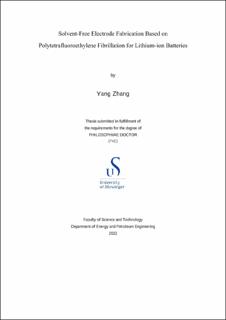| dc.contributor.advisor | Yu, Zhixin | |
| dc.contributor.advisor | Lou, Fengliu | |
| dc.contributor.author | Zhang, Yang | |
| dc.date.accessioned | 2023-01-30T09:36:37Z | |
| dc.date.available | 2023-01-30T09:36:37Z | |
| dc.date.issued | 2023 | |
| dc.identifier.citation | Solvent-Free Electrode Fabrication Based on Polytetrafluoroethylene Fibrillation for Lithium-ion Batteries by Yang Zhang, Stavanger : University of Stavanger, 2023 (PhD thesis UiS, no. 683) | en_US |
| dc.identifier.isbn | 978-82-8439-147-2 | |
| dc.identifier.issn | 1890-1387 | |
| dc.identifier.uri | https://hdl.handle.net/11250/3047016 | |
| dc.description.abstract | The commercial lithium-ion batteries (LiBs) electrodes are manufactured with slurry casting (SC) procedure, where a large amount of energy is consumed, increasing the manufacturing cost a lot. In addition, the SC procedure limits the fabrication of thick electrode caused by binder floating during drying process. Developing new procedures for electrode manufacturing to improve specific energy and lower cost is highly desired. One of the most promising technical routes to achieve the goal is solvent free (SF) procedure for electrode fabrication, where no solvent is involved, thus avoiding drawbacks of SC procedure. SF procedure for electrode fabrication has attracted tremendous attention both from academia and industry, especially polymer (polytetrafluoroethylene (PTFE)) fibrillation-based procedure, because the roll-to-roll process make the procedure compatible to commercial LiBs production line.
During this procedure, PTFE is fibrillated under high shear force to generate fibrils to bundle active materials together to form self-supporting electrode film when the fibrillated dry mixture is hot rolled. However, PTFE is instable under low voltage, making this procedure is not suitable for anode fabrication. On the other hand, the procedure works well with activate carbon or lithium nickel manganese cobalt oxide materials (NMC), but it cannot be used for lithium iron phosphate (LFP). In this project, we fabricated SF anodes with different active materials including graphite, hard carbon, and soft carbon. SF hard carbon and soft carbon electrodes with low volume variation during charge/discharge cycling showed good cycling life, while SF graphite electrode with big volume swelling and shrinking demonstrated fast capacity fading. With comprehensive study of different anodes, the failure mechanism of SF anodes was proposed that PTFE is reduced to amorphous carbon at first lithiation process. For the graphite electrode, the big volume swelling and shrinking makes the electrode lose the integrity and results in fast capacity fading. While the hard carbon and soft carbon electrodes can keep the integrity of electrodes even though the PTFE is reduced because the volume variation is small. Basing on insights of the failure mechanism, dual binder system was adopted to address the instability issue of PTFE fibrillation-based SF graphite anode, where PTFE acted as self-supporting electrode formation aid reagent, while polyvinylidene fluoride (PVDF) acted as functional binder. With the help of PVDF, the SF graphite anode demonstrated good cycling stability.
To further expand the application of PTFE fibrillation-based SF electrode manufacturing, LFP cathode was fabricated successfully with the help of carbon nanotubes (CNT). CNT on the one hand acted as conductive additive to increase the conductivity of the electrode. On the other hand, CNT played the role as LFP powders matrix to ensure further PTFE fibrillation, which is essential for self-supporting LFP electrode film formation. Finally, SF LPF/hard carbon full cells were assembled and demonstrated good stability with more than 95% of capacity retention after 50 cycles under 0.5 C in coin cells. With prelithiation, the initial coulombic efficiency (ICE) of full cell increased to close to 100%, which showed big advantage of prelithiation in specific energy enhancement. | en_US |
| dc.language.iso | eng | en_US |
| dc.publisher | Stavanger : University of Stavanger | en_US |
| dc.relation.ispartofseries | PhD Theses;883 | |
| dc.relation.haspart | Paper 1: Zhang, Y., Huld, F., Lu, S., Jektvik, C., Lou, F., & Yu, Z. (2022). Revisiting Polytetrafluorethylene Binder for Solvent-Free Lithium-Ion Battery Anode Fabrication. Batteries, 8(6), 57. https://doi.org/10.3390/batteries8060057 | en_US |
| dc.relation.haspart | Paper 2: Zhang, Y., Lu, S., C., Lou, F., & Yu, Z. (2022) Leveraging Synergies by Combining Polytetrafluorethylene with Polyvinylidene Fluoride for Solvent-Free Graphite Anode Fabrication. Energy Technology, 10(11), https://onlinelibrary.wiley.com/doi/epdf/10.1002/ente.202200732 | en_US |
| dc.relation.haspart | Paper 3: Zhang, Y., Lu, S., Wang, Z., Volkov, V., Lou, F., and Yu, Z. Recent Technology Development in Solvent-Free Electrode Fabrication for Lithium-Ion Batteries (Submitted) | en_US |
| dc.relation.haspart | Paper 4: Zhang, Y., Lu, S., Lou, F. & Yu, Z. Solvent-free Lithium Iron Phosphate Cathode Fabrication with the Fibrillation of Polytetrafluoroethylene. (Submitted) | en_US |
| dc.subject | petroleumsteknologi | en_US |
| dc.subject | litium-ion batterier | en_US |
| dc.subject | løsemidler | en_US |
| dc.title | Solvent-Free Electrode Fabrication Based on Polytetrafluoroethylene Fibrillation for Lithium-ion Batteries | en_US |
| dc.type | Doctoral thesis | en_US |
| dc.rights.holder | ©2022 Yang Zhang | en_US |
| dc.subject.nsi | VDP::Teknologi: 500::Berg‑ og petroleumsfag: 510::Petroleumsteknologi: 512 | en_US |
